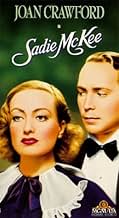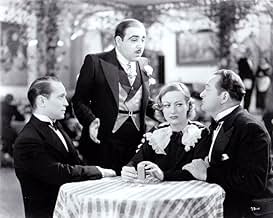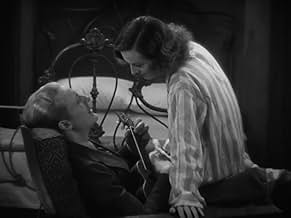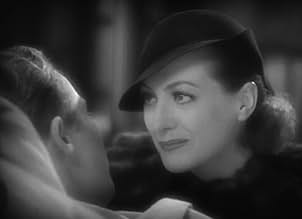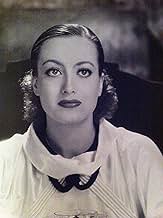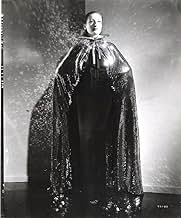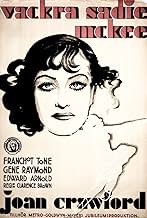IMDb RATING
6.8/10
1.8K
YOUR RATING
A working girl's fortunes improve when she marries into money, but happiness is not so easily won.A working girl's fortunes improve when she marries into money, but happiness is not so easily won.A working girl's fortunes improve when she marries into money, but happiness is not so easily won.
- Director
- Writers
- Stars
- Awards
- 3 wins total
Leo G. Carroll
- Phelps
- (as Leo Carroll)
Candy Candido
- Cafe Entertainer
- (as Candy and Coco)
Otto Heimel
- Cafe Entertainer
- (as Candy and Coco)
Hooper Atchley
- Intern with Dr. Briggs
- (uncredited)
Nellie Bly Baker
- Downstairs Laundress
- (uncredited)
Jack Baxley
- Short-Order Cook
- (uncredited)
- Director
- Writers
- All cast & crew
- Production, box office & more at IMDbPro
Featured reviews
Clarence Brown was an above average director and his pictures with Joan Crawford in the early and mid '30s are better than those she did with others. Brown had an eye and a sense of detail and he favors long takes with two or more performers interacting, which creates a certain tension where there might otherwise be none. Certainly this improbable script is not noticeably better than others Joan did around that time, but everything about this picture works perfectly.
Having finally found her best 'look,' Crawford is undeniably gorgeous, the ravishing epitome of glamor. And Adrian does some of his best work for her in this, putting her in one stunning and flattering gown after another. She is also given a talented and varied supporting cast and all of the big set pieces work, though Edward Arnold's drunk scenes go on for too long.
And there are a couple of fantastic sets, one of Arnold's mansion and the other of a glass sanitarium in the snow. Though the whole cast is more than adequate, a few players stand out: Jean Dixon is delightfully world weary in a leopard coat, Esther Ralston makes a perfect amoral siren, and it's a bit of a revelation to see how much Leo G. Carroll accomplishes by doing very little in his role as a nasty butler. There's also a fantastic jazz version of "After You've Gone" performed by Gene Austin, Candy Candido and Otto Heimel. As for the main players, Crawford, Franchot Tone and Gene Raymond don't dig very deep in their performances, but with a plucky, luscious Crawford at full tilt and with everything else about this movie clicking so well, it doesn't matter. It works.
Having finally found her best 'look,' Crawford is undeniably gorgeous, the ravishing epitome of glamor. And Adrian does some of his best work for her in this, putting her in one stunning and flattering gown after another. She is also given a talented and varied supporting cast and all of the big set pieces work, though Edward Arnold's drunk scenes go on for too long.
And there are a couple of fantastic sets, one of Arnold's mansion and the other of a glass sanitarium in the snow. Though the whole cast is more than adequate, a few players stand out: Jean Dixon is delightfully world weary in a leopard coat, Esther Ralston makes a perfect amoral siren, and it's a bit of a revelation to see how much Leo G. Carroll accomplishes by doing very little in his role as a nasty butler. There's also a fantastic jazz version of "After You've Gone" performed by Gene Austin, Candy Candido and Otto Heimel. As for the main players, Crawford, Franchot Tone and Gene Raymond don't dig very deep in their performances, but with a plucky, luscious Crawford at full tilt and with everything else about this movie clicking so well, it doesn't matter. It works.
It's easy to see why films like this made Crawford the idol of millions of young women across the country. It's the epitome of a "vehicle".....a film designed to display all the talents of a star and make audiences fall for them. As in many of her early films, she begins at the bottom...the daughter of the cook for a wealthy family including Tone. She gets a hot scene right off the bat when she angrily defends her boyfriend, who is being derided by the aristocrats at the table, by telling them all off (this moment actually brings to mind Emily Watson's similar, yet much more subdued, scene in "Gosford Park".) Soon she and lover Raymond are off to NYC. This section is fascinating as it portrays the way diners were in that era. There's an astonishing coffee dispenser that is shown in one scene and the Automat is quite interesting to behold (not to mention the corned beef hash and 2 poached eggs for $0.35!) Circumstances progress to where she is working in a dance hall (and showing some positively scary legs! It amazing how times have changed in that, today, a similar dancer would have to have sticks for legs and breasts out to there, etc....) Here she becomes associated with a drunken millionaire (Arnold) who takes a major shine to her. Fortunately, for the viewer, she sticks with him, so she can wear an array of dazzling Adrien gowns and furs. Ultimately, each of the men in her life (Tone, Raymond, Arnold) presents her with a variety of conflicts and decisions....all of which she handles with the utmost nobility and grace. She is photographed magnificently throughout with her amazing profile and luminescent eyes featured repeatedly. It's a good thing the film is in black and white because she'd be too much to deal with in color! Everyone knows that Hurrell retouched his amazing portraits of her, but here she looks quite wonderful with just make up and good lighting. The plot is creaky and contrived and the film is just plain out of date, but it's great to see Joan in action in her quintessential role and there's a decent performance from Arnold and nice work by several other supporting players including Hitchcock favorite Carroll. One fun thing to watch for: As a precursor of the later, more antagonistic Crawford, Joan gets fed up with a nightclub singer, barks at her to "Shut up!" and shoves her backwards into a trunk! Fun stuff.
Joan Crawford is "Sadie McKee" in this 1934 film also starring Gene Raymond, Edward Arnold, Franchot Tone, and Jean Dixon. Crawford is the daughter of the cook for the wealthy Alderson family. The young man of the family, Michael (Tone) has obviously fallen for Sadie, but her heart belongs to loser Tommy Wallace (Raymond), who has just been fired for a malfeasance. Sadie runs off to New York with Tommy, and the two wind up in the rooming house of Mrs. Craney. The next day, they are to be married at City Hall at noon. But showgirl Dolly Merrick (Esther Ralston) who also lives at the rooming house, hears Tommy's dulcet tones and convinces him to forget marriage, leave town, and take a job in her traveling show.
Another women rooming at Mrs. Craney's is Opal, who gets Sadie a job at her club. There Sadie meets the filthy rich, drunken Jack Brennan, whom she marries. It turns out that Jack's drinking has all but destroyed his health. Though Sadie can't stop thinking about Tommy, she is determined to help Jack quit drinking and regain his health.
Pretty good melodrama, with Crawford wearing some fabulous outfits. Esther Ralston was a gorgeous blonde and is a lively Dolly Merrick, and Jean Dixon gives a good performance as Opal.
The debonair Franchot Tone gives a smooth performance as Michael, and Gene Raymond sings and acts pleasantly enough as Tommy, who manages to be likable though he walked out on Sadie.
Crawford made a lot of this type of film -- the working girl who moves up in class -- and they were very popular. She gives an appealing performance, and she was one actress who could look and act like a hard-working girl who came from a slum and also pull off being glamorous and wealthy.
Worth seeing.
Another women rooming at Mrs. Craney's is Opal, who gets Sadie a job at her club. There Sadie meets the filthy rich, drunken Jack Brennan, whom she marries. It turns out that Jack's drinking has all but destroyed his health. Though Sadie can't stop thinking about Tommy, she is determined to help Jack quit drinking and regain his health.
Pretty good melodrama, with Crawford wearing some fabulous outfits. Esther Ralston was a gorgeous blonde and is a lively Dolly Merrick, and Jean Dixon gives a good performance as Opal.
The debonair Franchot Tone gives a smooth performance as Michael, and Gene Raymond sings and acts pleasantly enough as Tommy, who manages to be likable though he walked out on Sadie.
Crawford made a lot of this type of film -- the working girl who moves up in class -- and they were very popular. She gives an appealing performance, and she was one actress who could look and act like a hard-working girl who came from a slum and also pull off being glamorous and wealthy.
Worth seeing.
I'd have to describe Sadie McKee as both the typical Joan Crawford vehicle and the typical Franchot Tone vehicle. The two of them who were husband and wife when the film was made are perfectly cast in roles that typified their images in the Thirties.
Crawford is the daughter of a cook on the sumptuous palatial Long Island estate where Tone is the young heir and a lawyer by trade. To earn a few extra bucks Crawford occasionally helps mom out serving at formal meals.
At one of those meals she hears Tone disparaging her sweetheart Gene Raymond who was caught in a petty theft. Tone makes a big point in saying we can't give people like these help because they're no good. Crawford throws a fit and runs to Raymond.
She almost marries Raymond, but he runs out on her for Esther Ralston. In New York working as a nightclub cigarette girl she runs into Edward Arnold who is a millionaire with a severe drinking problem. No doubt caused by drinking a lot of rotgut liquor during recently repealed Prohibition. And wouldn't you know it, Tone is his lawyer.
So Sadie has her three men, give you one guess who she winds up with in the end. You'd probably guess right, but let's say it's a character altering experience for all.
Sadie McKee is probably a good example of the Joan Crawford shop girl before she became a hardened creature like Crystal Allen in The Women. As for Franchot Tone, MGM just loved casting him as rich men in a tuxedo, probably because he looked so darn good in them. The only way either of them escaped type casting was as they got older they varied their parts due to age. Crawford was ever the film star, even in some of the horror flicks she did in the sixties. Tone went right into television and worked steady right up to his death.
Sadie McKee however is a good opportunity to see them both young and at the height of their fame. Also note the Nacio Herb Brown-Arthur Freed ballad All I Do Is Dream Of You comes from Sadie McKee.
Crawford is the daughter of a cook on the sumptuous palatial Long Island estate where Tone is the young heir and a lawyer by trade. To earn a few extra bucks Crawford occasionally helps mom out serving at formal meals.
At one of those meals she hears Tone disparaging her sweetheart Gene Raymond who was caught in a petty theft. Tone makes a big point in saying we can't give people like these help because they're no good. Crawford throws a fit and runs to Raymond.
She almost marries Raymond, but he runs out on her for Esther Ralston. In New York working as a nightclub cigarette girl she runs into Edward Arnold who is a millionaire with a severe drinking problem. No doubt caused by drinking a lot of rotgut liquor during recently repealed Prohibition. And wouldn't you know it, Tone is his lawyer.
So Sadie has her three men, give you one guess who she winds up with in the end. You'd probably guess right, but let's say it's a character altering experience for all.
Sadie McKee is probably a good example of the Joan Crawford shop girl before she became a hardened creature like Crystal Allen in The Women. As for Franchot Tone, MGM just loved casting him as rich men in a tuxedo, probably because he looked so darn good in them. The only way either of them escaped type casting was as they got older they varied their parts due to age. Crawford was ever the film star, even in some of the horror flicks she did in the sixties. Tone went right into television and worked steady right up to his death.
Sadie McKee however is a good opportunity to see them both young and at the height of their fame. Also note the Nacio Herb Brown-Arthur Freed ballad All I Do Is Dream Of You comes from Sadie McKee.
Joan Crawford acts up a storm in this well done, interesting soap opera like story of working girl Sadie, daughter of a cook, who is madly in love with a loser named Tommy (played by Gene Raymond). Sadie and Tommy run off together to NYC where they soon take up residence in this shabby, one-room apartment. The next day, big plans for job hunting and a noon appointment at the city hall to get married, but unfortunately for Sadie, Tommy the Rat is thrown in the path of a bad blonde/singer named Dolly who hires him on the spot to sing in her act, they kiss and run off together leaving poor Sadie waiting at the so-called altar. But Sadie pulls herself up by her boot straps, gets a job as a dancer, and meets a multi-millionaire (Edward Arnold) with a big drinking problem, while still holding the torch for her beloved Tommy.
This film is quite a good one, the story completely held my interest, and the acting is top-notch with Joan Crawford giving out her full emotional range, Edward Arnold is excellent playing drunk for the majority of his scenes, and Esther Ralston does a good job as Dolly, the loose hipped, barely able to sing man-snatcher. Franchot Tone plays a lawyer, the son of the well-to-do home where Sadie was raised - he isn't given as much to do here as I would have liked but still gives a satisfying performance, and he certainly looks handsome enough, as usual. The film includes a few fun to watch musical numbers, plus some interesting scenes filmed in diners and a neat old-time Automat.
This film is quite a good one, the story completely held my interest, and the acting is top-notch with Joan Crawford giving out her full emotional range, Edward Arnold is excellent playing drunk for the majority of his scenes, and Esther Ralston does a good job as Dolly, the loose hipped, barely able to sing man-snatcher. Franchot Tone plays a lawyer, the son of the well-to-do home where Sadie was raised - he isn't given as much to do here as I would have liked but still gives a satisfying performance, and he certainly looks handsome enough, as usual. The film includes a few fun to watch musical numbers, plus some interesting scenes filmed in diners and a neat old-time Automat.
Did you know
- TriviaOne of the first films to treat alcoholism as a serious problem, instead of a comic device.
- GoofsWhen Tommy is in his hospital room he makes Dr. Briggs promise not to tell Sadie of his condition. However, when Dr. Briggs leaves the room, Sadie is there with the other doctors and she already knows. Dr. Briggs then says, "He made me promise he wouldn't tell her." This dialogue obviously makes no sense and is wrong. What he meant to say was, "He made me promise not to tell her."
- Quotes
Sadie McKee Brennan: [showing off her bedroom] Here it is.
Opal: Lady, when you say, "I do take thee," how you take him.
Sadie McKee Brennan: [chuckles]
Opal: Got this all to yourself?
Sadie McKee Brennan: Yep, all to myself.
Opal: Always all to yourself?
Sadie McKee Brennan: Yep.
Opal: Well, a whole lot of us do a whole lot more for a whole lot less.
- ConnectionsFeatured in Qu'est-il arrivé à Baby Jane? (1962)
- SoundtracksAll I Do Is Dream Of You
(1934) (uncredited)
Music by Nacio Herb Brown
Lyrics by Arthur Freed
Played during the opening credits
Sung by Gene Raymond three times
Sung also by Earl Oxford in a show
- How long is Sadie McKee?Powered by Alexa
Details
Box office
- Budget
- $612,000 (estimated)
- Runtime1 hour 33 minutes
- Color
- Aspect ratio
- 1.37 : 1
Contribute to this page
Suggest an edit or add missing content


